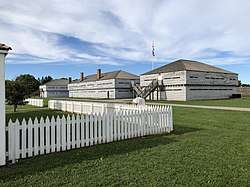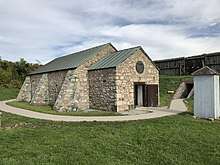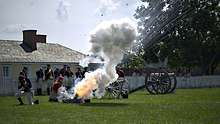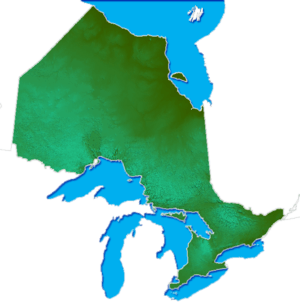Fort George, Ontario
| Fort George National Historic Site of Canada | |
|---|---|
 View from inside Fort George | |
| Location |
51 Queen's Parade Niagara-on-the-Lake, Ontario, Canada L0S 1J0 |
| Coordinates | 43°15′03″N 79°03′40″W / 43.25083°N 79.06111°WCoordinates: 43°15′03″N 79°03′40″W / 43.25083°N 79.06111°W |
| Built | 1796–1799 (original) |
| Original use | Military fort |
| Current use | Living museum |
| Governing body | Parks Canada |
 Location of Fort George National Historic Site of Canada in Southern Ontario | |
| Designated | 21 May 1921 |
Fort George National Historic Site is a historic military structure at Niagara-on-the-Lake, Ontario, that was the scene of several battles during the War of 1812. The fort consists of earthworks and palisades, along with internal structures, including an officer's quarters, blockhouses to accommodate other ranks and their families, and a stone powder magazine, which is the only original building on the site. Opposite the fort, across the Niagara River, stands Fort Niagara in New York, which can be seen from Fort George's ramparts.[1]
History
Fort George was built by the British Army after Jay's Treaty (1796) required Britain to withdraw from Fort Niagara. Construction for the new fort took place from 1796 to 1799, and became the regional headquarters for the British Army and the Canadian Militia.[2]

Several battles broke out within the vicinity of the Fort during the War of 1812. Major General Sir Isaac Brock of the British Army served here during the early stages of the war, until he was killed in the Battle of Queenston Heights on October 13, 1812 while trying to regain the heights. (That goal was achieved after his death by troops under Major-General Roger Hale Sheaffe.)[3]
During the Battle of Fort George the fort was taken by American forces in May 1813 after a two-day bombardment by cannon from Fort Niagara and the American Fleet, followed by a fierce battle. Most of the buildings were destroyed. Brigadier General John Vincent ordered the troops to evacuate the fort to minimize the number of casualties.[4] [5] Afterwards, the Americans built their own fortifications here [6] and used the fort as a base to invade Upper Canada. They were repelled at the Battles of Stoney Creek and Beaver Dams. The fort was retaken by the British Army in December 1813 after U.S. forces abandoned the British side of the river. It was then left to fall into ruins and was eventually abandoned.[7]
The fortification was used by the Canadian Army as a military training base during the First World War and through the Second World War under the name Camp Niagara. The military left the grounds in 1966.[8]

The site was reconstructed in the 1930s and is now staffed by costumed interpreters. It is a National Historic Site of Canada, maintained by Parks Canada with operating hours varying as appropriate to the season.[9] The staff maintains the image of the fort as it was during the early 19th century, with period costumes, exhibits, and displays of that time. They train summer students in the infantry tactics and firing drills of the 41st regiment from the War of 1812. They also have the 41st Fife and Drum Corps which provides an example of how the fife and drums were used.
Reenactors from both the United States and Canada meet on and near the grounds of the fort and reenact the battle that took place in May 1813. This has taken place since 1984 and has grown from a small group of 300 "troops" to over 1800. The interpreters and infantry members are dressed in period dress and uniforms. Infantry soldiers, officers and fifes and drums are dressed representing the 41st Regiment of Foot. The reproduction British 8" mortars are a unique pattern found nowhere else. Fort George National Historic Site is one of a handful of sites managed under the administrative name "Niagara National Historic Sites" by Parks Canada, within the national park system.

The grounds surrounding the fort and the commons adjacent to the fort provided the site for the 8th World Scout Jamboree held in August 1955.
The television show The Girly Ghosthunters paid a visit to the fort to investigate any paranormal activity that was allegedly documented there. The episode was shown as the second, of thirteen, episodes of the show in 2005.
Museum affiliations
The museum is affiliated with: Canadian Museums Association, Canadian Heritage Information Network, and Virtual Museum of Canada and also the Upper Canada heritage centre. It has been a historical site since the mid 1900s.
See also
References
- ↑ "Fort George National Historic Site of Canada". www.pc.gc.ca. 2012-03-15. Retrieved 2013-09-24.
- ↑ "Fort George National Historic Site of Canada". Historic Places. Parks Canada. Retrieved 12 October 2018.
- ↑ http://www.waynecook.com/aniagara.html, Plaque 23
- ↑ http://www.warof1812.ca/ftgeorge.htm
- ↑ http://www.friendsoffortgeorge.ca/fort-george/history/
- ↑ http://www.waynecook.com/aniagara.html, Plaque6
- ↑ http://www.waynecook.com/aniagara.html, Plaque6
- ↑ https://memoriesofniagara.wordpress.com/the-military/
- ↑ Canada, Parks Canada Agency, Government of. "Parks Canada - Fort George National Historic Site - Hours of Operation". www.pc.gc.ca. Retrieved 2016-11-04.
External links
| Wikimedia Commons has media related to Fort George National Historic Site. |
